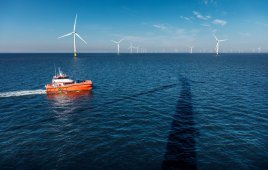Offshore wind has dominated the industry news cycle, and will likely maintain its position as a prominent development in renewables. But the aquatic turbine towers shouldn’t overshadow a number of other noteworthy federal and technological developments related to wind that are worth looking into.
Deploying drones

Two-thirds of the energy sector deploys drones for a variety. In wind, the unmanned aerial vehicles are a safer alternative to having inspectors scale turbine towers.
Unmanned aerial vehicles have streamlined turbine blade inspections by keeping boots on the ground and drones in the sky. Fewer trips up turbines minimize fall and drop risks for O&M technicians and, with drones, inspection on a single turbine can be finished in 15 minutes. The tiny aircraft can work on predetermined paths and fly much closer to blades than a person can safely reach.
Drones are deployed by about for two-thirds of the energy sector, according to a white paper, and it’s believed more companies will follow.
Production tax credits expire
The Production Tax Credit (PTC), initially enacted in 1992, runs up to 2020. The PTC let wind developers take advantage of a tax credit per-kilowatt-hour when selling produced energy to off-takers. It has been a successful incentive for wind development — as well as geothermal energy, hydroelectric and others — with a higher tax credit amount than the remaining eligible energy sources.
Despite off and on years in the 1990s and 2000s, PTC established a foothold in 2015 when it was extended through 2019. The American Wind Energy Association (AWEA) predicts the wind industry won’t falter after the PTC expires, “because the PTC has been successful in helping establish a reliable, competitive domestic wind industry,” the organization’s website states. But the kilowatt-hour tax cuts will no longer be available.
However, if construction on new wind projects starts by December 31, 2019, they are still eligible for the tax credit.
Cybersecurity
Wind farms and other energy utilities can work at higher efficiencies using the latest operating and monitoring programs, however, as automation advances so does the need for proper protection. Top cybersecurity officials said they’re trying to keep pace with outside threats attempting to breach the regulating software used in the energy sector.
If control of a wind farm is seized by outside parties, they can potentially damage the turbine towers. Having access to a turbine’s braking system and suddenly stopping the spinning blades can be harmful. Unauthorized users can also send inaccurate information back to turbine analysts.
Director of National Risk Management Bob Kolasky said data analytics and data aggregation are necessary to predict and assess cyber threats. Companies can prevent attacks by investing in a cybersecurity workforce and establishing best practices and security standards in houses. Work accounts should have multiple levels of security, with passwords changed regularly to prevent breaches.
Predictive maintenance
Experts predict artificial intelligence will become a standard for industries across the board. Using all the available data in a company, AI can learn how operations are carried out, and eventually make predictive suggestions with a lower margin for error than humanly possible.
For wind, the machine will eventually learn a wind farm’s controls, component failures, and loads on individual turbines. This means O&M technicians can skip analyzing turbine data and focus on other tasks, like fixing the component failures the AI predicted.
Wind simulations
What if wind developers could study turbine component designs prior to manufacturing and installation? The National Renewable Energy Laboratory released an open-source program called the Simulator for Wind Farm Applications (SOWFA), which, as the name suggests, gives developers the option to simulate wind, weather, and terrain efficiency on a turbine site.
Simulation saves wind EPCs from the trial-and-error of hands-on component field testing, while also giving predictive measurements for on an existing wind farm.
Once in operation, SOWFA can pinpoint inefficiencies in a wind farm, alleviating underperforming turbines, component degradation, and other operating concerns. Having testing complete at an early stage cuts costs for a total wind farm project.
Filed Under: Cybersecurity, O&M, Software



